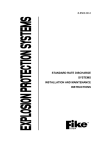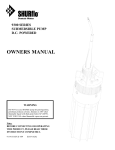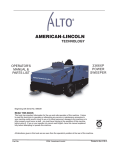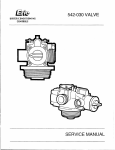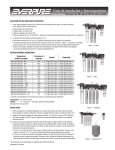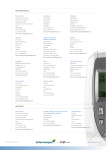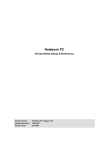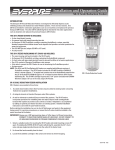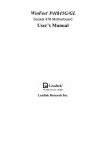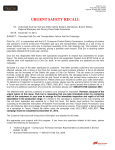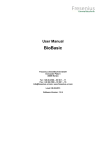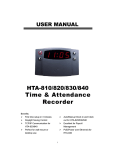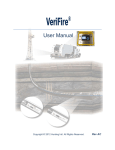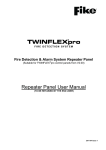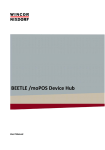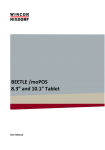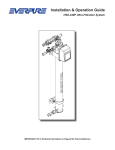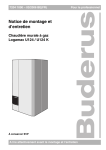Download explosion protection system hrd suppression
Transcript
8.8601.00.4 EXPLOSION PROTECTION SYSTEM HRD SUPPRESSION CONTAINER INSTALLATION AND MAINTENANCE INSTRUCTIONS µ 8.8601.00.4 July, 2003 Explosion Protection Systems HRD Suppression Container Installation and Maintenance Instructions REVISIONS LETTER 2 3 4 DATE 02/01 02/2003 06/2003 BY GB JS SM DESCRIPTION New Lay-out General revision for Atex certification § 7.2 Periodic maintenance TABLE OF CONTENTS 1 INTRODUCTION ........................................................................................................... 1 1.1 SCOPE .................................................................................................................................... 1 1.2 FIKE EXPLOSION SUPPRESSION CONCEPT ............................................................................. 1 1.3 DEFINITIONS .......................................................................................................................... 2 2 WARNINGS ..................................................................................................................... 4 3 HRD SUPPRESSION CONTAINER............................................................................. 5 4 3.1 DESCRIPTION ......................................................................................................................... 5 3.2 IDENTIFICATION OF SUPPRESSION CONTAINERS ................................................................... 5 HRD SUPPRESSION CONTAINER INSTALLATION ............................................. 9 4.1 MECHANICAL INSTALLATION ................................................................................................ 9 4.2 CONTAINER PRESSURISATION ................................................................................................ 9 4.3 ACTUATOR INSTALLATION & HANDLING ............................................................................. 10 5 HRD SUPPRESSION CONTAINER REFURBISHMENT....................................... 11 6 ACTUATOR INSTALLATION & HANDLING ........................................................ 13 7 6.1 ACTUATOR ASSEMBLY......................................................................................................... 13 6.2 PERSONAL SAFETY MEASURES ............................................................................................ 14 6.3 ELECTRICAL SAFETY PROCEDURES...................................................................................... 14 6.4 ACTUATOR INSTALLATION................................................................................................... 14 6.5 ACTUATOR EXCHANGE ........................................................................................................ 14 PERIODIC MAINTENANCE ...................................................................................... 15 7.1 GENERAL ............................................................................................................................. 15 7.2 PERIODIC INSPECTION:......................................................................................................... 16 7.3 THREE-MONTHLY SERVICE / INSPECTION BY FIKE: ............................................................. 16 7.4 THREE-YEARLY.................................................................................................................... 17 7.5 FIVE-YEARLY ....................................................................................................................... 17 7.6 TEN-YEARLY ........................................................................................................................ 17 8 DE-COMMISSIONING PROCEDURE / CHECK-LIST.......................................... 18 9 REPAIR AND RETURN AUTHORISATION............................................................ 19 Document 8.8601.00.4 Page i FIGURES FIGURE 1: SUPPRESSION CONTAINER TYPES ........................................................... 5 FIGURE 2: CONTAINER IDENTIFICATION PLATE (NAMEPLATE) ................................ 5 FIGURE 4: HRD SUPPRESSION CONTAINER (TYPICAL) ............................................ 7 FIGURE 5: SPREADER NOZZLES: STANDARD AND TELESCOPIC ................................ 8 FIGURE 7: SUPPRESSION CONTAINER FILLING PRESSURE......................................... 9 FIGURE 9: DETONATOR ASSEMBLY (TYPICAL)...................................................... 13 Document 8.8601.00.4 Page ii 1 INTRODUCTION 1.1 SCOPE This document is intended to provide information and assist with the maintenance and repair of Fike Europe 2.5 litre, 5 litre, 10 litre, 20 litre, 30 litre and 50 litre explosion suppression containers. Individuals should read this manual carefully. Specific sections will be of particular interest depending upon specific responsibilities. This information shall be used in conjunction with the drawings and additional information provided for the specific application. 1.2 FIKE EXPLOSION SUPPRESSION CONCEPT The risk of an industrial explosion occurs in many stages of production, transport, and storage of combustible dusts and gases. Apart from all the known preventive measures to avoid conditions, in which explosions may occur, a large number of constructive protection measures can be taken. Protective techniques are classified into explosion venting, suppression and isolation. Explosion venting and explosion suppression are designed to protect process vessels from over pressurisation. Explosion isolation prevents explosions from spreading throughout a process. By isolating the explosion, the effect of an explosion is limited to the equipment where the explosion initially occurred. Responsive explosion suppression systems act upon the detection of an explosion at its incipient stage. These systems prevent pressure increase beyond a predetermined limit by instantaneously discharging the suppressant powder, which chemically extinguishes the combustion reaction. To suppress explosions the suppression system proceeds through 3 basic sequences: detection, initiation and suppression. Refer to Fike document 8.6501.00.x (Suppression Container HRD – Specifications and Installation Instructions). Document 8.8601.00.4 Page 1 1.3 DEFINITIONS HRD-Suppressor (High Rate Discharge): Appliance containing an explosion suppressant that can be expelled by the action of internal pressure. Suppressant: Substance contained in the suppressor that, when dispersed into a volume to be protected, can arrest or prevent a developing explosion in that volume. Three categories of suppressants are in general use, separately or in combination (powder, water, halon-carbons). Powder suppressant: Powder with recognised flame extinguishing properties such as products based on mono-ammonium phosphate, potassium bicarbonate or sodium bicarbonate. Such suppressants may contain additives to improve their flow properties and their effectiveness. Actuator: Initiating device to open the HRD container, typically a gas generator (GCA or Gas Cartridge Actuator) or detonator. Explosion sensor: Device that is responsive to the changes of environmental parameters such as pressure caused by a developing explosion. Explosion detector: Device or arrangement of apparatus, containing one or more explosion sensors, that responds to a developing explosion by providing an explosion detection signal. Explosion: The propagating of a flame in a premixed dispersion of combustible gases dusts or mixtures of these, in a gaseous oxidant such as air in a closed or substantially closed vessel. Deflagration: Explosions which propagate because of heat transfer and having two distinctive and separate parts - a pressure wave and a flame. The deflagration type of explosion is generally referred to as a combustion reaction where the flame front burns into the unburned material at a velocity lower than the speed of sound. The Fike hardware is designed to provide protection against deflagrations only, not against detonations unless otherwise specified. Dispersion nozzle: A discharge-device fitted on a Suppressor or the protected installation and designed to deploy the suppressant into the equipment to be protected. Control and indicating Equipment (CIE): Equipment which records and monitors the signals transmitted by explosion pressure sensors / detectors spark and flame, temperature and other safety sensors. Depending on configuration, by interrogation and interpretation of the detector / sensor data the CIE selectively controls the actuation of Suppressors, extinguishing barriers, fast closing isolation valves, process equipment shut down, water spray or extinguishant release, and all audible and visual alarms. The CIE must be constructed according to special specifications. Explosion Protection System Controller (EPSC): Fike equivalent name for CIE. Zone: A zone that is protected against an explosion; it consists of protection devices that are electrically linked with detectors. A validated (acknowledged) detection signal will activate the explosion protection devices for that specific protected zone. Document 8.8601.00.4 Page 2 Armed: the EPSC is active and will process a detection signal. Disarmed: the EPSC is inactive and will not process a detection signal. Shutdown: Disarm action followed by the dischargeing of the capacitors of a CIE/EPSC. Consequently, the power to fire the actuator is no longer present. Therefore, shutdown is safer than DISARM. Shutdown must be used during maintenance to an area of plant, where people can enter the protected volume. Shutdown also guarantees a safe state of the circuitry for the operator or technician for maintenance or measurements. Fike Service Sign: The sections marked with this icon require specialist assistance. ONLY CERTIFIED FIELD SERVICE ENGINEERS SHALL PERFORM THE ACTIONS DESCRIBED IN THESE MARKED SECTIONS. Document 8.8601.00.4 Page 3 2 WARNINGS WARNING: ALL MAINTENANCE WORK SHOULD BE EXECUTED BY CERTIFIED FIELD SERVICE ENGINEERS. ONLY COMPONENTS SUPPLIED BY FIKE i.e RELOAD KITS, SPARE PARTS ETC., SHOULD BE USED TO REFURBISH THE CONTAINERS. FIKE SHALL NOT BE LIABLE FOR CONSEQUENTIAL DAMAGES TO FIKE ASSEMBLIES, COMPONENT PARTS OR HARM TO PERSONNEL IF WORK TO THE FIKE EQUIPMENT IS CARRIED OUT BY NONE FIKE CERTIFIED ENGINEERS. THE SECTIONS MARKED WITH THIS ICON REQUIRE SPECIALIST ASSISTANCE. PLEASE CONTACT FIKE FOR INFORMATION, ASSISTANCE OR SERVICE TRAINING PROGRAMS. WARNING: SUPPRESSION CONTAINERS ARE NOT DESIGNED TO BE EXPOSED TO VIBRATIONS. FOR MORE DETAILS OR IN CASE OF DOUBT CONTACT FIKE. WARNING: ONLY QUALIFIED FIKE PERSONNEL HAVE THE AUTHORITY TO INSTALL / REMOVE ACTUATORS. WARNING: IN MANY COUNTRIES THE TRANSPORT, STORAGE AND USE OF ACTUATORS ARE CONTROLLED BY GOVERNMENT RULES AND OFFICES. THE LOCAL AUTHORITIES MUST BE CONSULTED BEFORE TRANSPORT, USE OR INSTALLATION OF THESE DEVICES AND THE RELEVANT PERMITS OBTAINED WARNING: ACTUATORS ARE PYROTECHNIC DEVICES THAT CAN CAUSE BODILY INJURY AND / OR EQUIPMENT DAMAGE IF NOT HANDLED CORRECTLY. ONLY AUTHORIZED PERSONS SHALL WORK WITH THESE DEVICES AND MUST BE FAMILIAR WITH AND UNDERSTAND THE RELEVANT PROCEDURES. WARNING: TO PREVENT POSSIBLE INJURY, THE ACTUATOR MUST BE DISCONNECTED AND SHUNTED WHENEVER PERFORMING ANY OF THE REFURBISHMENT AND REBUILD PROCEDURES. WARNING: IN NORMAL CIRCUMSTANCES, ACTUATORS ARE THE LAST PART TO BE INSTALLED AND MAY ONLY BE INSTALLED WHEN EQUIPMENT AND SYSTEM HAVE BEEN CHECKED. Document 8.8601.00.4 Page 4 3 HRD SUPPRESSION CONTAINER 3.1 DESCRIPTION The Fike explosion suppression containers, used in conjunction with other Fike explosion system components, are designed to suppress explosions originating in vessels or prevent flame propagation through ducts or conveying lines to downstream equipment or other operating locations. Figure 1: Suppression container types Fike Suppressant Containers are incorporated into the protection system to perform vital system functions. The controlled and predictable release of the suppressant powder is a vital function. Release of this media results from an electrical signal generated by the CIE or EPSC. The electrical signal is transmitted to an actuator that instantly opens the rupture disc. Upon opening of the disc, the suppressant powder flows out of the container. The rate and velocity of the discharging suppressant powder are a function of the container outlet diameter, suppressant container geometry, initial pressurisation level, temperature, flow path restrictions, and dispersion nozzle design. 3.2 IDENTIFICATION OF SUPPRESSION CONTAINERS 3.2.1 HRD-container: Nameplate II 2/1 G/D Ineris 03ATEX0058X EExd IIC T6 IP66 T65°C To identify the suppression container and order replacement parts, the containers have been permanently labelled. The container identification plate, located on the cylindrical shell of the container, contains among other things following information: Serial No, Gross Weight, Next inspection date, Suppressant type, Suppressant Qty in Kg and Filling pressure (see Figure 2). Figure 2: Container identification plate (nameplate) Document 8.8601.00.4 Page 5 Document 8.8601.00.4 Page 6 3.2.2 HRD-container: Component parts 13 Figure 3: HRD suppression container (typical) N° Item description N° Item description 1 2 3 4 5 6 7 Pressure gauge Fill valve HRD suppressant container Bracket for nameplate Actuator boss Electrical EExd junction box Cable gland 8 9 10 11 12 13 14 15 Electrical shielded cable Equipotential connection Stud M27 Nut Vessel wall, reinforcement plate Process flange Spreader nozzle, nozzle cover Lifting lug Table 1: Component parts Document 8.8601.00.4 Page 7 3.2.3 HRD-containers: dimensions Container type / volume (litre) Max. dimensions (mm) A 2.5 5 10 20 30 50 Weight empty (Kg) B 500 610 870 950 1160 1310 310 400 400 470 470 620 C Thrust (N) D 430 470 470 470 470 628 ∅ 114 ∅ 168 Ø 168 Ø 273 Ø 273 Ø 273 30 42 46 75 85 150 8900 13345 22241 40034 44482 67000 Table 2: Dimensions (see details Figure 4) 3.2.4 HRD-containers: dispersion nozzles Fike can supply 2 types of dispersion nozzle. The standard spreader nozzle assembly has a fixed position in the vessel wall. The telescopic spreader nozzle on the other hand is stored outside of the process vessel and is moved forward to protrude into the vessel when the system is activated. Standard spreader nozzle Telescopic spreader nozzle Figure 4: Spreader nozzles: standard and telescopic N° Item description N° Item description 10 Stud M27 20 Holddown 11 Nut 21 Spreader nozzle cover telescopic 13 Process flange telescopic nozzle 22 Quad ring nozzle 14 Standard Spreader nozzle cover 23 Spreader nozzle telescopic 17 O-ring 24 Weldment telescopic 18 Rupture disc 25 Process flange 19 Cap-screws 26 Standard Spreader nozzle Please consult the Fike relevant documents for a complete updated overview of nozzle configurations (Fike doc. 8.6503.00.x). Document 8.8601.00.4 Page 8 4 HRD SUPPRESSION CONTAINER INSTALLATION WARNING: THE CONTAINER MUST BE INSTALLED BEFORE PRESSURISATION! 4.1 MECHANICAL INSTALLATION Use the lifting lug (item 15, Figure 3) to manipulate the suppressant container. The suppressant container requires sufficient structural support based on its weight and the dynamic and static forces created during operation. Refer to Figure 4 and the Fike supplied Engineering Drawings for the physical specifications of the suppressant container. The suppressant container must be mounted to the process vessel using studs and nuts (Fike supply unless otherwise specified). The nuts must be torqued to 81 Nm uniformly, in a criss cross pattern in one-third increments (26Nm –53Nm – 81Nm) using a torque wrench. 4.2 CONTAINER PRESSURISATION Fike suppressant containers are factory filled with suppressant powder. After installation, the containers must be pressurised by a Fike Service Engineer during start-up of the system (dry nitrogen, initial pressure 62 barg at 22°C). It is possible that the fill valve/gauge assembly is supplied in a separate carton box, to prevent damages due to shipment. In this case, install the valve/gauge assembly on the top mounted boss, after having removed the plastic protection cap. Make sure all surfaces are clean and free from debris prior to installation. Use vacuum grease onto the O-ring and groove, tighten untill the nut bottoms out. Refer to Figure 5 for the required filling pressure if the ambient temperature differs from 22°C to prevent accidental firing and possible injury due to overfilling. Figure 5: Suppression container filling pressure Document 8.8601.00.4 Page 9 To assure start-up, commissioning and fast reconditioning of the explosion protection devices, the user should provide a stand-by filling station meeting the requirements as per Fike document 8.6605.00.x (Nitrogen filling requirements). 4.3 ACTUATOR INSTALLATION & HANDLING Refer to SECTION 6 ACTUATOR INSTALLATION & HANDLING for details on installation of the actuator. Refer to the relevant CIE, EPSC manual and site specific drawing package for the completion of the controller wiring and system checkout. Document 8.8601.00.4 Page 10 5 HRD SUPPRESSION CONTAINER REFURBISHMENT After an activation and the suppressant powder has been released, the container has to be refurbished. The Fike HRD suppressant containers are designed to allow easy and quick on-site refurbishment. When refurbishing an explosion suppression container, the following parts are required. 1. An explosion suppression reload kit which consists of: an actuator boss and O-ring a 4" or 6" disc assembly with O-ring suppressant powder (SBC or Dessikarb) 2. Nozzle cover: standard or telescopic, in silicone (S) or metal (M); 3. Actuator (detonator or GCA) in safety enclosure. WARNING: ONLY QUALIFIED FIKE PERSONNEL HAVE THE AUTHORITY TO INSTALL / REMOVE ACTUATORS. 5.1. Check on the container identification plate if the container is due for inspection or testing. WARNING: BEFORE STARTING ANY WORK, ENSURE THE PRESSURE GAUGE READS ZERO. WARNING: TO PREVENT POSSIBLE INJURY, NO ACTUATOR SHALL BE INSTALLED WHEN PERFORMING ANY OF THE FOLLOWING ACTIONS. 5.2. Remove the container from the process vessel. Make sure that only the nuts are unscrewed while the studs remain inserted in the process flange. The studs will ease container removal. First remove the lower nuts, leave the upper nut to be unscrewed as the last of all to simplify container removal. 5.3. Place the container in a horizontal position, be careful not to damage the gauge or valve. Remove the outlet disc holddown flange from the container flange. 5.4. Remove the opened rupture disc and O-ring. WARNING: THE OPENED RUPTURE DISC IS VERY SHARP AND CAN CAUSE INJURY. HANDLE WITH CARE! 5.5. Clean the fill valve with pressurised air and make sure the valve seat is dirt free. In case of doubt about the condition of the fill valve and/ or the gauge, a new gauge and Valve pre-assembly must be installed (refer to the Fike suppression spare part list). Document 8.8601.00.4 Page 11 5.6. Remove the jam nut to release the old actuator boss and o-ring. Clean the o-ring seat and apply sufficient high vaccum grease (Dow Corning) on the o-ring and it’s groove. Install a new actuator boss and o-ringboss. The junction box can be removed to make the removal and installation of the actuator boss easier. 5.7. Refill the container (still in horizontal position) with the correct type and quantity of suppressant powder, using a funnel. When filling larger containers it is necessary to incline the container slightly to prevent air becoming trapped in the container. 5.8. Clean the seat and install a new rupture disc and new O-ring. Apply sufficient high vacuum grease (Dow corning) on the O-ring and its groove. 5.9. Re-install the holddown on the rupture disc, lubricate the bolts (item 19) and torque to 81 Nm uniformly in a criss-cross pattern in one-third increments (26 Nm - 53 Nm - 81 Nm). 5.10. Remove the opened spreader nozzle cover from the spreader nozzle assembly. Apply a new cover on the spreader nozzle. 5.11. When a telescopic spreader nozzle is used, clean all the moving (not painted) parts and lubricate them with chassis grease. Inspect the condition of the quad-ring and exchange if necessary. Install the quad-ring on the tip of the nozzle to ensure optimal nozzle position. 5.12. Mount the container and re-install the container washers & nuts, torque uniformly in a criss-cross pattern in one-third increments increments (26Nm –53Nm – 81Nm) using a torque wrench. 5.13. Install a new actuator see SECTION 6. 5.14. The container can now be pressurissed. Check the container identification plate for the applicable fill pressure and pressurise with dry nitrogen (initial filling pressure: 62 barg at 22°C ambient temperature). Refer to Figure 5 for the required filling pressure when the ambient temperature differs from 22°C. Check for leaks using a suitable leak detection spray or liquid. Document 8.8601.00.4 Page 12 6 ACTUATOR INSTALLATION & HANDLING WARNING: ONLY QUALIFIED FIKE PERSONNEL HAVE THE AUTHORITY TO INSTALL / REMOVE ACTUATORS. The actuators of the Fike Explosion Protection Systems are widely used in industrial applications but must be respected for their extremely fast response and the possibility of accidental detonation. When actuators are handled in accordance with all proper safety practices, accidental detonations should not occur. WARNING: TO PREVENT POSSIBLE INJURY, THE ACTUATORS MUST BE DISCONNECTED AND SHUNTED PROCEDURES. 6.1 WHEN PERFORMING ANY OF THE FOLLOWING ACTUATOR ASSEMBLY Each actuator is transported in a safety boss with two safety caps. In order to exchange an overdue actuator, an additional, empty actuator transport boss is required to hold the overdue actuator. WARNING: ACTUATORS ARE INDIVIDUALLY LABELLED IDENTIFICATION. DO NOT REMOVE THIS LABEL! TO ENABLE PROPER In the figure below a detonator in safety housing is shown (typical arrangement). Figure 6: Detonator assembly (typical) N° Item description N° Item description 27 28 29 30 31 32 Original cap detonator wire Shunted lead wires Detonator tag Cable length 1 m Retainer nut 2 component epoxy glue 33 34 35 36 37 38 Pipe Detonator Jam nut Safety cap O-ring Detonator boss Document 8.8601.00.4 Page 13 6.2 PERSONAL SAFETY MEASURES When handling actuators: 6.3 wear approved face protection; do not wear static electricity producing clothing; always put the safety cap on the actuator boss when removing it from the equipment. Alternatively, actuator handling is also safe if the actuator is held into a safety transport boss; do not handle more than one actuator at the same time; do not expose actuators to high heat sources as this may considerably affect their service life. ELECTRICAL SAFETY PROCEDURES When handling actuators: 6.4 actuators must remain shunted at all times when electrically disconnected from the protection system and during servicing; do not check actuator continuity with any type of Ohm-meter or other measuring device; do not install actuators if current is present on conduit or equipment; do not install actuators if radio transmitters or wireless telephones are used in nearby areas; connect actuator lead wires only after the detonator assembly has been properly installed. ACTUATOR INSTALLATION ONLY QUALIFIED FIKE PERSONNEL HAVE THE AUTHORITY TO INSTALL ACTUATORS. 6.5 ACTUATOR EXCHANGE ONLY QUALIFIED FIKE PERSONNEL HAVE THE AUTHORITY TO REMOVE ACTUATORS. Refer to datasheet 8.6502.00 (Reload parts HRD) for further information and material listing. Document 8.8601.00.4 Page 14 7 PERIODIC MAINTENANCE CAUTION: BEFORE MAINTENANCE OR SERVICE TO THE SYSTEM IS PERFORMED, MAKE SURE TO BE FAMILIAR WITH THE SYSTEM OPERATION, INDIVIDUAL COMPONENT OPERATION, AND SYSTEM SAFETY. THE PROTECTED PROCESS MUST BE IN A NON-HAZARDOUS STATE. 7.1 GENERAL In order to assure the SAFETY FUNCTION of the Fike protection system it is essential that the integrity of the system remains. In order that your company can benefit from our after sales services (in case of emergencies) a service contract should be set up prior to or just after commissioning. Once the contract is in place you will receive our emergency (24 hour) telephone numbers. Remarks: 1. We recommend that a service be carried out every 3 months. 2. Fike is unable to provide any additional support other than that stated in Fike’s standard conditions of sale, unless a service contract is established. The inspection schedule and procedure set forth below are provided as a minimum requirement for Fike Explosion Protection Systems operating in moderate environments. If your particular protection system does not employ all the equipment mentioned, disregard the appropriate instruction. The instructions are to be implemented in conjunction with complete system inspection instructions. During initial system checkout or start-up, the Fike Service Engineer may decide that - due to the process characteristics - additional inspections are required. In such case, these are to be considered in addition to the maintenance schedule given below. It is extremely important to closely monitor the operational characteristics of your system during the first few days or weeks after initial start-up. Document 8.8601.00.4 Page 15 7.2 PERIODIC INSPECTION: The following checks can be conducted by others than Fike. It is advised to conduct these checks at regular intervals (once a week) and to file the results in a logbook. In this way, the Fike Service Engineer will have a clear overview of the system status and behaviour during time. Furthermore, this logbook will be very helpful for trouble shooting and system analysis upon system trouble conditions. 1. Before performing an inspection, it is important to obtain first all pertinent data related to the specific system inspected. The information required includes and should be obtained from: Fike System Engineered Drawings Copy of manuals, specifications or documents referenced on Fike system drawings. System owner’s operating procedures Inspection equipment Operating specifications of each component inspected. 2. Check the display of the CIE or EPSC: in normal status, only the green LED’s on the front panel should be lit. Consult the applicable EPSC user manual if this is not the case. in normal status all programmed outputs should be switched active or armed. REFER TO THE APPLICABLE EPSC USER MANUAL to perform any action on the explosion controller. 3. Visually check all components for physical deterioration and abuse. If components’ ability to perform is in question, they must be thoroughly tested and/or replaced. Do not submerge components in liquids. 4. Check all components supporting hardware, mounting brackets, and bolts. Check if they are tight and secure, replace if necessary. 5. Check the actual fill pressure of all pressurised components, top-up if necessary (Refer to § 4.2 Container Pressurisation). 6. File a complete and detailed report of the inspection findings with the system owner, servicing company, and Fike. 7.3 THREE-MONTHLY SERVICE / INSPECTION BY FIKE: A three-monthly inspection must be performed by a Fike Service Engineer or factory authorised technicians. Consult Fike to schedule an inspection visit or for information on authorisation for system service by others than Fike. To perform an inspection, it is important to obtain first all pertinent data related to the specific system inspected. The information required includes and should be obtained from: Fike System Engineered Drawings Copy of manuals, specifications or documents referenced on Fike system drawings. System owner’s operating procedures Inspection equipment Operating specifications of each component inspected. Document 8.8601.00.4 Page 16 During this 3-monthly inspection, the Fike Service Engineer (further on called SE) proceeds following checks: 1. SE shuts down the Fike CIE or EPSC. SE then removes the actuators from the electrical circuit to ensure the highest possible level of safety & security while working. 2. SE proceeds through a visual check of all components for physical deterioration and abuse. If components’ ability to perform is in question, he will thoroughly test or even replace the specific component(s). 3. SE checks all components supporting hardware, mounting brackets, and bolts to be tight and secure. 4. SE checks the actual fill pressure of all pressurised components. 5. SE links a portable PC to the EPSC for a full-automatic system check. This software checks the electronic addresses of the EPSC and the proper functioning of the controller. 6. SE also uses this Fike software to check whether all process equipment shutdown contacts controlled by the Fike system - operate in the appropriate sequence. 7. SE uses the Fike software for measureing the condition of the complete field wiring installation. 8. SE checks the explosion pressure detectors calibration for the activation pressure set point, calibration adjusted as required. 9. SE to file a complete and detailed report of the inspection findings. A copy of this report will be sent to the system owner or servicing company, Fike will retain a copy for their records. 7.4 THREE-YEARLY 1. A three-year inspection includes the replacement of all batteries, -EEPROMS. 7.5 FIVE-YEARLY 1. A five-year inspection includes the replacement of all detonators - actuators. Refer to the applicable safety procedure. 2. National guidelines may require periodic testing of the suppression containers (pressure vessel code). It is the responsibility of the owner to contact your local authorities having jurisdiction. 7.6 TEN-YEARLY 1. A ten-year inspection includes the replacement of all suppressant powder and GCA-actuators. Refer to section 5 Refurbishment instructions. NOTE: The 3-, 5-, and 10-year replacements are based on a 60°C maximum service temperature. More regular replacement may be necessary in case of higher temperatures or harsh operational environments. Document 8.8601.00.4 Page 17 8 DE-COMMISSIONING PROCEDURE / CHECK-LIST The following procedure must only be performed by a Fike qualified Service Engineer, who has been assigned to prepare and complete the de-commissioning of the above referenced Explosion Protection System. Each step in the listed procedure must be adhered to and completion/acceptance of this form is mandatory. The Service Engineer must check off each of the following steps. In the case of noncompliance, the observed discrepancy must be corrected before completion of the system decommissioning. STEPS / DESCRIPTION 1. Use Fike system/project component location diagram to record and verify the locations of all Fike system components for each zone and system. pass fail Remark/ Note No. 2. Control Panel to be Disarmed/Shutdown. pass fail Remark/ Note No. 3. All Suppressor/Valve actuators to be shunted. pass fail Remark/ Note No. 4. Each Suppressor/Valve container to be depressurised. Note, Do not ventilate Nitrogen in a confined space. pass fail Remark/ Note No. 5. Power supply to the Control Panel to be Isolated by the Customer and disconnected to prevent accidental reconnection. Fike to Verify. pass fail Remark/ Note No. 6. Control Panel battery to be disconnected and removed for disposal. pass fail Remark/ Note No. 7. Each actuator is to be removed and placed in a storage boss, to be either stored on site or removed for disposal. pass fail Remark/ Note No. 8. Verify that all Suppressor/valve gauges are reading zero, replace fill valve cap loosely pass fail Remark/ Note No. ATTENTION: SYSTEM IS NOW DE-COMMISSIONED AND READY FOR DISMOUNTING BY THE CUSTOMER/OWNER. Document 8.8601.00.4 Page 18 9 REPAIR AND RETURN AUTHORISATION Any component that is to be returned to Fike must be approved for return prior to shipment. In order for the returned component to receive the correct attention * credit * repair * replacement * either under warranty or at the owner's expense, an Material Return Authorisation number must be assigned by Fike. A prearranged return authorisation will expedite the business and corrective action measures taken upon receipt of the part(s). A reference to the return authorisation number should be inserted to the packing slip. If a packing slip is not used, then reference to the return authorisation number should be made through alternate means. When preparing the component for shipment, please include your original Purchase Order Number, Invoice Number, or Fike Production Order Number. Include with the package the address you want the part shipped back to, shipment method, contact name, and telephone number. A specific statement as the perceived defect or component failure will assist in examining the part(s). This statement should also address symptoms and an operation history of the system in which the component was installed. In the event the suspect part is found within a larger top assembly component, the party assigning the Material Return Authorisation Number (MRA) should be able to assist you as to whether the entire assembly must be returned or only the component in question. Return Address: Fike Europe B.V.B.A. Toekomstlaan 52 B-2200 Herentals BELGIUM tel. +32 14 21 00 31 fax +32 14 21 07 43 Attention: Explosion Protection MRA # __________ Document 8.8601.00.4 Page 19























